Morozov
A.N.
ABOUT
USING SPRINKLING IRRIGATION IN ģTHE KIZILKUM DESERT
Here
is an interesting but, unfortunately, forgotten by people story of
successful using sprinkling in the ģ Kizilkum desert. Yes, truly,
in the Kizilkum desert at the Mingbulak depression which is marked
even in school maps as an alkali soil. Probably there is no need to
say about the nature of Kizilkum, sand storms, about very hot summer
period and sufficiently inclement winter, about poor fertility and
high water permeability of desert-sand soils; this all is given in
any manual of geography. We shall tell, how and why virtually all
available at that time means of irrigation technique were tested there,
what that resulted in.
The
Uzbek "Grazing and reclamation building trust" during 1960-1980
periods had to found in the Kizilkum desert irrigation sites on the
basis of artesian wells, that would allow providing the sheep stock
with the guaranteed forages for the winter period, growth of which
was restrained due to lack of the guaranteed forage supplies during
a period when pastures are covered with deep snow. 
My
father, Morozov Nikolay Leonidovich,
was one of the active ideologists, managers, and executors of that
action.
At
the Mingbulak depression, sufficiently great amount of self-streaming
artesian water of relatively high quality was found (figures 1 and
2).


Figures
1 and 2. A drilling rig and a tent camp of drillers at the Mingbulak
depression.
Explored
artesian water allowed organizing a production ground for desert reclamation.
On the spot of those holes, the "Artesian" village was built
up (fig.3), and irrigated sites were founded.

Figure
3. "Artesian" village
First
of all, the people developing the forage-providing areas faced such
a problem as delivering the water from the holes to fields, since
over a half-kilometer distance the water was lost to filtration. On
figure 2, near to the drillers' tents, one can see a supply feeder
in a sand channel; and below, on figure 4, you can see, how its bed
is eroded.
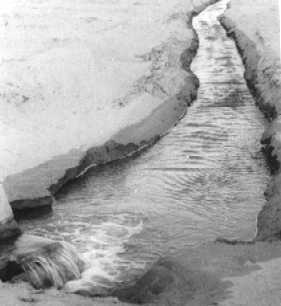
Figure
4. Erosion of the feeder' bed.
That
was a period, when reinforced-concrete troughs just began to be manufactured
in the Begovat plant for ferroconcrete items, but attempts to convey
those to the Artesian village were not succeeded, for then there was
no yet special machines for conveyance, and the ones split without
standing transport loads on filed roads of the desert. They had to
cover with facing of monolithic concrete, and the problem of water
delivery to the fields was settled. Application of concreted feeders
and even pipelines saved much water, but did not afford the chief
thing - high yield and steady reclamation state. The point is that
further the developing people faced another challenge: the water delivered
to a field with such losses soaked into high-permeable sands and did
not "want" to run over the field until groundwater table
rose to the soil surface! (Oddly enough, it turned out that water
in free state always flows top-down!). Owing to that, for irrigation,
water was consumed a few times more than was needed for the plants,
efficiency of feeders came to no more than 0.2 ha/day! Groundwater
rise just in the first years caused progressive salinity of the lands,
since the irrigated areas were situated at a closed depression and
did not have natural outflow of groundwater that was strongly fed
by losses on the fields.
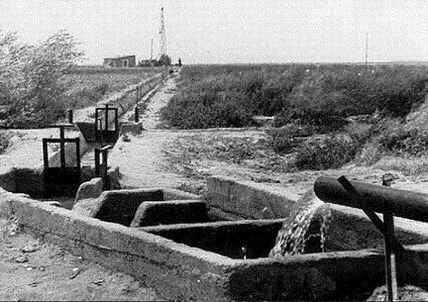
Figure
5. Feeders in concrete facing.
On
pictures 6-9 you can see, how in sequence, using all known methods
of surface irrigation (flooding checks, by strias and furrows by means
of flexible hoses), they tried to cultivate fodder crops. However,
the result remained oppressive: reclamation state of the fields became
crucially worse; salinity increased; crop yield remained poor; water
for irrigating a needed area was not enough.
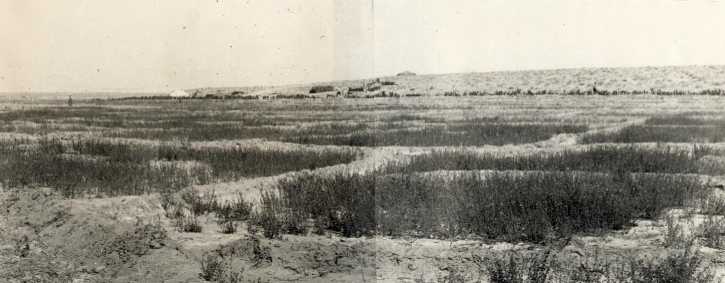
Figure
6. Irrigation of lucerne by flooding checks (it is easy to calculate
the efficient factor of using field surface!).

Figure
7. Irrigation of lucerne by strias from open temporary feeders.
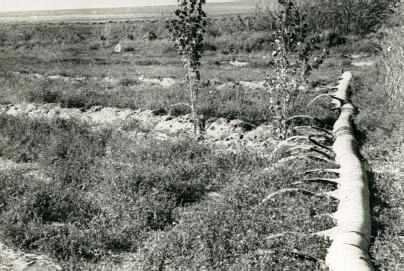
Figure
8. Irrigation of lucerne by strias from flexible hoses.
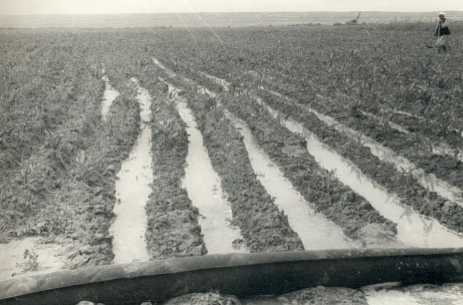
Figure
9. Irrigation of fodder crops by furrows.
Then,
mobile far-range sprinklers (irrigation guns) DDM-30 were applied
(fig.10), which were imperfect by quality of its sprinkling drops
and sprinkling uniformity (note, that was a forced measure, because
sprinkling was always coasted much!). These devices took water from
the concrete feeders. Their application sharply increased efficiency
of irrigation (by 8-10 times), reduced by several times irrigation
rates, improved reclamation state of the lands, and considerably raised
crop yield.
Special observations over water losses to evaporation during irrigation
and two following days showed that the ones did not exceed 8-10 %
of water supplied for irrigation, that is actually as much as with
surface irrigation methods during the same period.

Figure
10. Operation of a mobile far-range sprinklers (irrigation guns) DDM-30
during irrigation of lucerne.
Later,
more useful medium-range and short-range semi-stationary systems were
applied (fig. 11 and 12), with water supply in closed pressure conduits
(fig. 13) from artesian wells. These machines are much easier in operation.
They were served by 2 or 3 operators, duties of those consisted in
carrying the sprinklers' tails and opening and shutting the gate valves
on the stationary pressure pipelines strictly according to fixed time!
At that, problem related to timeliness of irrigation accurate to a
day was solved by itself, and irrigation rates accurate to 10-50 m3/ha,
that is of great importance on desert-sand soils of low moisture capacity
and is unachievable with other irrigation methods even on low water
permeable soils!
When
using closed pressure pipelines for water supply to sprinkling systems,
partially pressure of artesian water was used, but operating pressure
of 2-3 atm was produced by the pumping facilities.
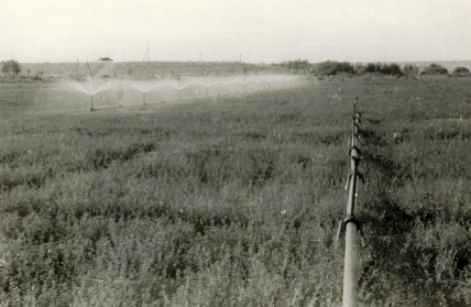
Figure
11. Operation of a short-range semi-stationary sprinklers during irrigation
of lucerne.
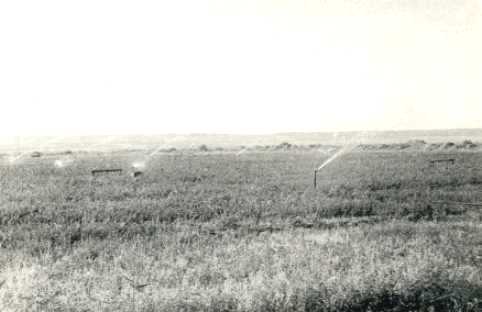
Figure
12. Operation of a medium-range semi-stationary sprinklers during
irrigation of lucerne.
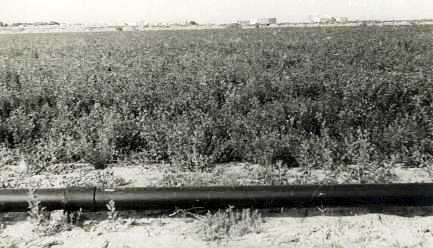
Figure
13. Feeding pressure pipeline to a semi-stationary sprinkling machine.
Sprinkling
applied on highly water-permeable soils completely settled problems
of swamping, salinizaton, and effective use of limited water reserves
in this region despite strong winds, high evaporation, and technical
complications in an under-habitable desert district of Uzbekistan.
This became possible only owing to perfect irrigation technique -
sprinkling. By this way, they irrigated 6000 ha (more than ever on
the all irrigated lands of Uzbekistan!). To save water resources,
they made hole cementation of the all artesian wells, and the wells
themselves were converted to the faucet mode (fig. 14).

Figure
14. Cap of an artesian well converted to the faucet mode.
Let
us try to make a resume of the all said. It is too easy to me, since
being a schoolboy long ago, I saw myself all stages of that involuntary
production experiment; though the task of the trust did not include
studying irrigation technique, and only receiving necessary plant
production for forage. Moreover, I being a student helped my father
in preparing his doctor thesis,
in particular, I printed all the photos from his work, given in this
page.
Step
by step, reacting to consequences of the production activity, the
whole range of methods for fighting against water losses and its low
efficiency were tried unwittingly, namely, anti-filtration measures
in supplying network and known surface irrigation ways. Application
of perfect irrigation technique (sprinkling) resulted in complex reclamation
effect in spite of extra-arid conditions, high wind "activity",
and low-fertile desert-sand soils. This once more corroborates the
conclusion made in the page "Irrigation
technique is a key to reclamation of salted lands"
regarding that perfect irrigation technique is a solution to reclamation
problem when irrigating sands under the desert conditions even at
brackish depressions. As to terrible stories about high cost of sprinkling,
so one should, all along, remember a motto of those times stating
that "economy should economical", and, therefore, count
not the money invested, but the total effect gained, which in any
cases covers the costs.
Return
to the main page

